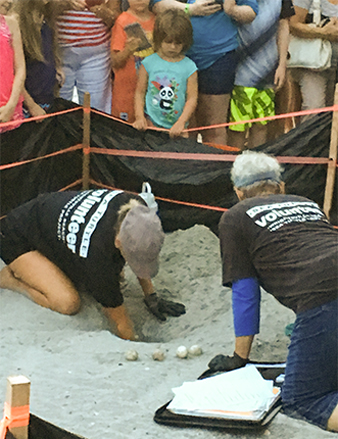
Before moving to Wilmington, Joseph and I had the privilege of witnessing our first sea turtle nest excavation. After a sunset swim during a dramatic thunderstorm, Joseph and I joined a large crowd gathered around a protected nesting site near the pier. Volunteers from Wrightsville Beach Sea Turtle Project were patiently digging to retrieve any eggs that had not yet hatched. The site and the path down to the water were cordoned off to protect any stragglers that might remain.
The crowd was lively and curious, and as we walked around to get a closer view of the nest, we kept hearing the same questions. How many eggs were there? What type of turtle was nesting here? How many of them make it to adulthood?
After the event, during which four golf-ball sized eggs were excavated, I talked to Susan Miller, one of the volunteers and a board member of WBSTP. I learned that in North Carolina, the nesting season is from May to September. Loggerheads, and occasionally green sea turtles, the enormous leatherbacks, and the highly endangered Kemp’s Ridley turtles nest on our beaches, while Hawkbill sea turtles can be found off the coast. This means that North Carolina has five out of the seven sea turtle species worldwide either on our beaches or in near-shore waters!
Adult female sea turtles can lay 3-6 nests per season and only emerge from the water only to nest or scout potential nesting sites (known as a “false crawl”). Male sea turtles never come onto land as adults. After struggling up a moonlit beach and arduously digging a nest with their back flippers, the gravid turtle lays anywhere from 90-120 eggs over the course of a few hours, diligently covers her nest, and then returns to the ocean. The eggs incubate for approximately 50-60 days and the temperature of the sand determines the gender—warmer sands produce mostly female sea turtles, and the relatively cooler sands of North Carolina produce mostly males.
Both the nesting process and incubation are fraught with potential dangers. Nesting turtles are easily disoriented by artificial light, loud noises, and pets. If you see a nesting female, please keep a respectful distance (at least 30 feet) and remain quiet during her time on the beach. Turn off all flashlights, and do not use flash photography. (A fact that the volunteers had to constantly remind the over-eager crowd at the beach during the excavation.)
Nesting sites are protected by state and federal law, and it is a crime to interfere with them. Turtles predate dinosaurs but face long odds: only 1 in approx. 1,000 to 10,000 turtles survives to adulthood, and turtles don’t reach sexual maturity until 30+ years of age.
If you’ve spent any time at the beach you’ve probably seen the reminders, “Lights out from May-October.” Reducing or eliminating artificial light is essential for the health and safety of both the mother and her brood.
Hatchlings are also vulnerable to light—after emerging from the nest. They navigate by the light of the moon and the stars, finding their way to the Atlantic by the soft reflection of the night skies on the water. Artificial light overwhelms these softer reflections and disorients hatchlings, causing them to crawl in the wrong direction and never reach the surf.
Sea turtles numbers have been in precipitous decline over the last century, sea turtle species worldwide are either classified as threatened or endangered. You can help sea turtles during the nesting season by:
- Keep our beaches clean, pick up trash, and don’t leave any items on the beach at night
- Turn off outdoor lights, and shield indoor lights from shining on the beach at night
- Don’t use flashlights, fireworks or flash photography on the beach at night
- Refill any holes dug in the sand
- Report sea turtle activities, injuries or stranding to 910 612 3047